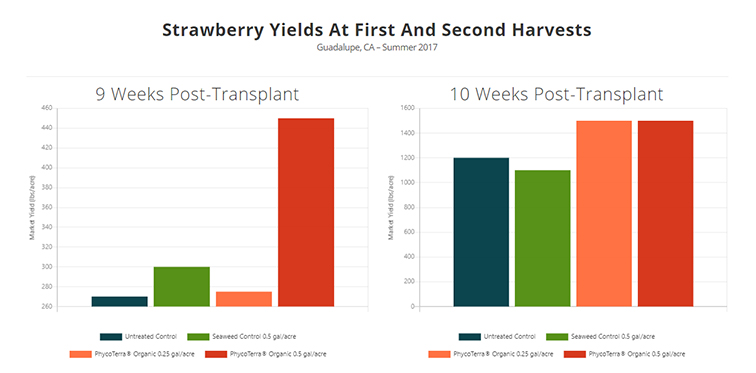Attendees Brave The Cold To Vet Hot Topics At IFTA Conference
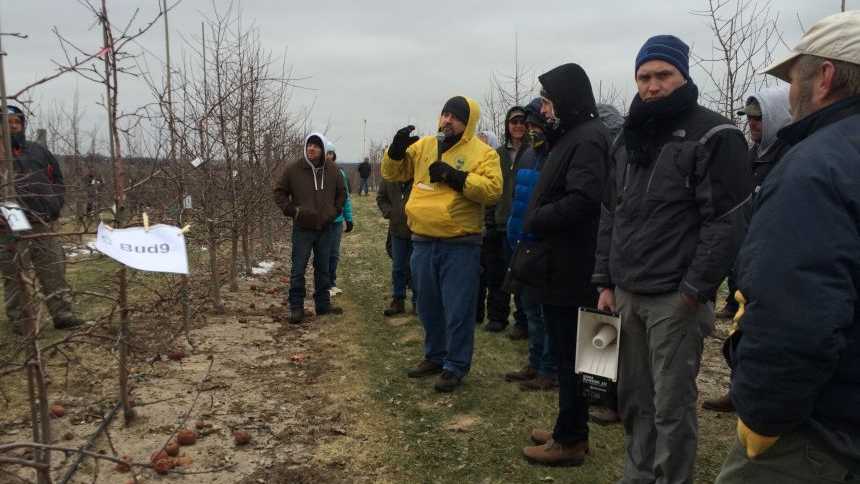
Gennaro Fazio talks about how Bud 9 performs in NC-140 rootstock trial on Honeycrisp at Joe Rasch Orchards LLC in Conklin, MI.
Photo by Christina Herrick
Rootstocks were a big part of the International Fruit Tree Association’s annual conference general session kickoff. And it’s no surprise since rootstocks play such a key role in all that tree fruit growers do.
In fact, Gennaro Fazio of USDA-ARS says he and his research team are learning just how much influence a rootstock can have on the scion. He says they are noticing the rootstock can change the scion at a molecular level, imparting some genetic traits to the scion, like fire blight resistance.
Fazio, of Geneva rootstock fame, says he is looking at genetic markers to help predict size, how PGRs will interact with the tree, and how fruit quality may be influenced by rootstock.
He also says chilling requirements are also influenced by rootstocks.
Fazio hopes through more studies to crack the calcium deficiency issues that Honeycrisp has.
Rootstocks also were a topic in sweet cherries were Lynn Long of Oregon State University reviewed his studies on the rootstocks currently available as well as some on the horizon.
Out West growers prefer the Krymsk series, which Long says is for many reasons, there are lower royalty costs, they perform well in hot climates, are moderately productive, and perform better than Mazzard.
Long says there is potential for the soon-to-be-released Weigi cherry rootstocks as well as two new Gisela rootstocks – Gi.13 and Gi.17. Studies continue to be conducted on the new Michigan State University rootstocks. He says the MSU rootstocks may be a game changer because some advance ripening, allowing growers to get in the market sooner.
*Want even more information about IFTA 2016? Follow Christina Herrick on Twitter (@HerrickAFG) and look for the hash tag #IFTAGrandRapids.*
Todd Einhorn of Oregon State University gave a look at current pear rootstock research and says OHxF 87 has performed the best, when compared with rootstock internationally available. The trouble with many rootstocks available internationally for pears, are most are not cold hardy.
Einhorn says cold hardiness is a focus of some upcoming studies on pear rootstock.
Greg Reighard of Clemson University focused on research in peach rootstocks.
The biggest challenge with peaches, he says is to “keep ’em alive.”
Reighard’s studies are to find rootstocks to modify the canopy for mechanization, tolerate soil conditions, and increase yield efficiencies.
He says some semi-dwarf and dwarfing peach rootstocks have survival issues. Also, some plum hybrids advance maturity.
But, he says MP.29 is one that is upcoming, as rootstock research continues in peaches.
Former IFTA president Wallace Heuser was honored both at the Monday session but also at the IFTA banquet Monday evening. IFTA created a lecture series honoring Heuser. Greg Lang was selected as the first presenter of the Wallace Heuser Presidental Lecture. Lang kicked off the annual conference general session presenting a look at sweet cherry research.
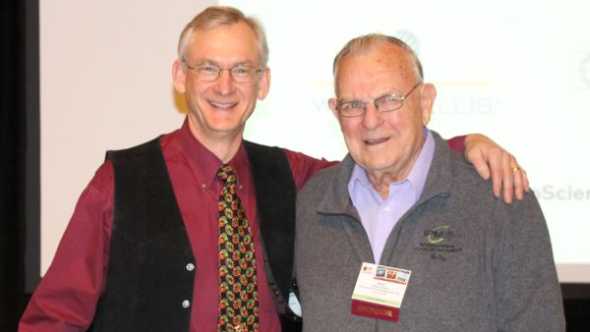
Greg Lang (left) and Wallace Heuser
Photo by Christina Herrick
Lang commented on how instrumental Heuser was in bringing Gisela rootstocks into the U.S., as well as securing royalties from rootstock purchases to be used toward IFTA research.
At the banquet Dan Boyer of Ridgetop Orchards in Fishertown, PA, was honored as an outgoing IFTA board member. “IFTA has given me more than I’ve given it,” Boyer said.
As in typical IFTA award fashion, there are a few surprises. Mainly because often the organizing committee members or IFTA board members are often recognized.
Amy Irish-Brown was named the 2016 Extension Person of the year. Irish-Brown is on the IFTA Grand Rapids planning committee.
Ed Wittenbach said he was proud to be on the selection committee who interviewed Irish-Brown. Her agriculture background stood out to the committee. “This gal was something else. It was like finding a gem in a sandbox,” Wittenbach said. “Amy makes Phil (Schwallier) look good.”
Randy Beaudry was named the 2016 Researcher of the Year.
Schwallier, a former IFTA president, said Beaudry is one of the best postharvest researchers on apples in the country. Irish-Brown commended Beaudry for his expertise and advice in setting up an apple maturity lab in Sparta, MI.
Beaudry, humbled by the award says “it’s been a wonderful opportunity to know so many farming families.”
Wittenbach was named the 2016 Grower of the Year.
“They’re giants in the industry,” former IFTA president Larry Lutz says about the Wittenbach family. “Take the opportunity to talk to them.”
Wittenbach, the 1999 American Fruit Grower® and Western Fruit Grower® Apple Grower of the YearSM, said the choice to grow apples was simple, his family had a dairy farm when he decided to join the family business. “If I had to milk cows for the rest of my life, I was going to leave the farm,” he said.
So, apples it was for the Wittenbachs, and the rest is history.
Ken Hall was honored with the 2016 Industry Service Award.
Tim Welsh, IFTA president, honored Hall as a great ambassador for IFTA. Welsh says Hall and his family’s Edwards Apple Orchard has mindboggling figures – 35 million visitors a year.
Welsh said what also is commendable is how Hall’s family rebuilt their business after losing their original barn to a tornado in 2008. “He has the knowledge, wisdom, and is transparent, and a man of integrity,” Welsh says.
Harold Thome, the 1992 Apple Grower of the Year Apple Grower of the Year, was named to IFTA’s Hall of Fame. “This award comes to someone who has served the industry well,” Welsh said.
Schwallier commended Thome for being a leader in the community and was always there to help Michigan State University unselfishly.
Thome said the highlight of his tenure with IFTA was when Bob Carlson asked him to be on the rootstock research committee.
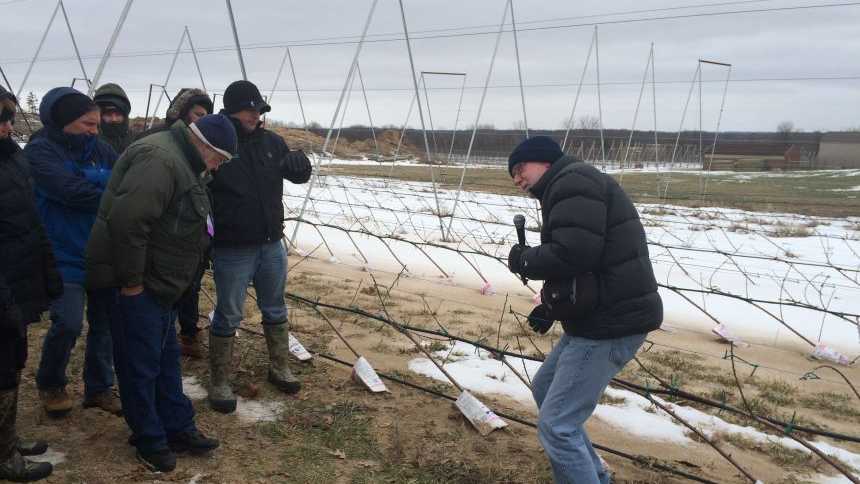
Lynn Long talks about what this 2015 UFO Benton on Gisela 3 planting needs to get established at Riveridge Land Company in Sparta, MI.
Photo by Christina Herrick
On the full-day IFTA orchard tours, growers constantly commented on how much production has changed on “The Ridge” since the last time the organization has been in Michigan.
Irish-Brown estimates about 50% or 60% of growers in The Ridge have transitioned to high density orchards.
Growers got a first-hand look at super high density at Riveridge Land Company in Sparta, MI, and a 2014 and a 2015 planting of V-system apples. This growing system popular in Washington state is experimental in the East.
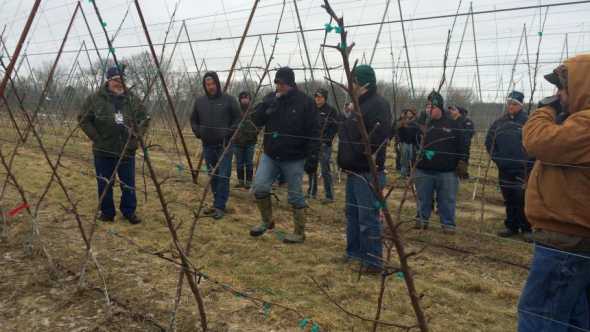
Justin Finkler leads the discussion in the orchard during IFTA 2016.
Photo by Christina Herrick
Justin Finkler of Riveridge says that the costs were higher than traditional tall spindle trellising to put in the steel beams and support, but estimates that when the system gets off the ground, Riveridge will make up any added structure costs very quickly, aiming to achieve around 100 bins to the acre once in full production.
While at the Rasch Family Orchards stop in Conklin, MI, growers got a chance to see a young planting of peaches starting their third leaf grown in a V-trellis system planted at 5-by-16-feet. The planting is at 1,000 feet in elevation, which is good for production of stone fruit.
However, Jake Rasch says the site is very prone to bacterial canker which has been problematic for the site.
The Rasches also have a 4-acre tall spindle planting of pears at 3-by-14-foot spacing. Jake Rasch said it is part of an experiment to see if they could grow the pears.
While at New Leaf Orchards in Kent City, MI, the Nyblad family has planted a multileader system. The eldest generation, Nick Nyblad worked with Alberto Dorigoni of Istituto Agrario Di San Michele All’Adige in Italy to bring this system to Michigan.
The Nyblads young planting has been defruited in the past years to encourage tree growth. The ultimate goal of this planting is to get the canopy full and ready for mechanization.
Gunnar Nyblad, as well as leading tourgoers on a look at his orchard, also offered visitors CDs of his band Gunner & The Grizzly Boys.
There were plenty of rootstocks to see at Joe Rasch Orchards LLC in Conklin, MI. Rasch and his family is collaborating with NC-140 on a Honeycrisp Trial. At the orchard there are 33 different rootstock that are being evaluated on the vigorous site.
Fazio says on the site, the cumulative yields have been best for trees on G.935 and G.11, and followed by B.9.
Tourgoers got a look at the Thome Orchards’ hedging trial which Michigan State University has been conducting for 3 or 4 years. While at Thome Orchards, growers got a chance to see all the latest equipment available.
Lunch was served at Storage Control Systems, which has graciously donated space for Michigan State University to house the MSU Apple Maturity Lab. From this lab, Amy-Irish Brown gave growers on the Ridge updates pm the fruit maturity as harvest time neared. This helped growers get more real-time information to make storage and marketing decisions for their fruit.
Growers also got a chance to see the state-of-the art packing line and cold storage rooms at Herren Companies in Comstock Park, MI.
Temperatures were cold for tours, and often a muffled round of applause from gloved hands would follow all thank-yous at every stop.







